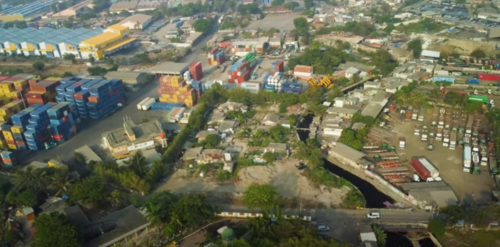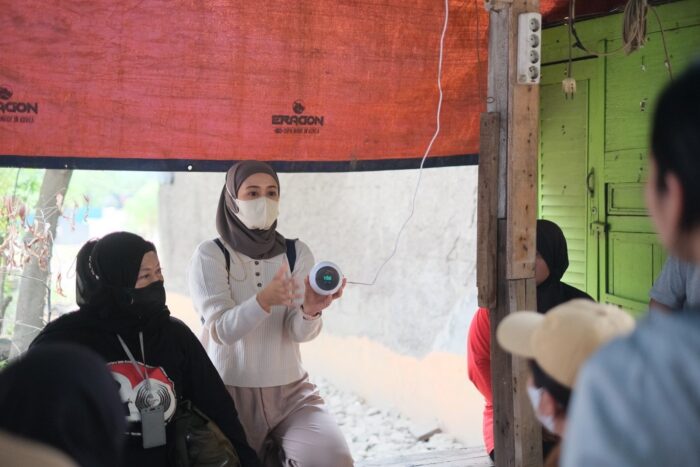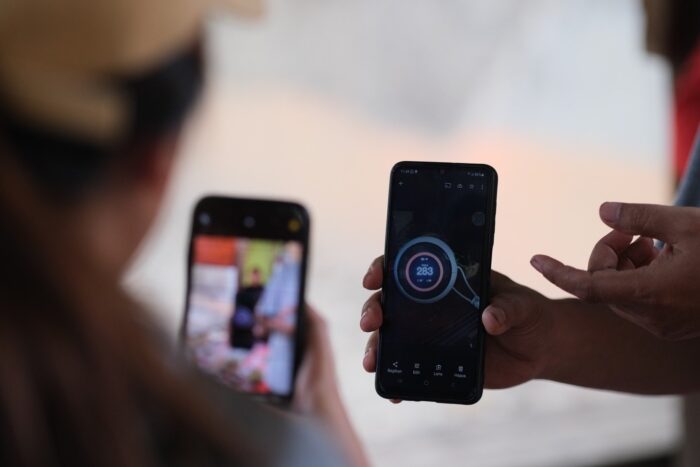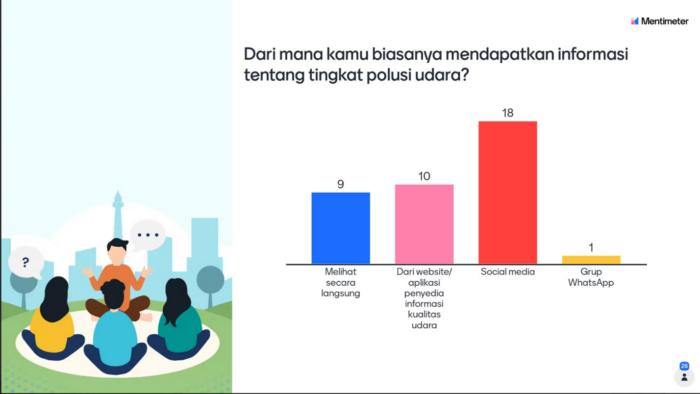Grassroot Actions Against Polluted Skies: How Jakarta’s Urban Villages Tackle Air Pollution

Clean Air Catalyst Hosts Learning Circles Workshop in Jakarta to Discuss Air Pollution Affects
On a Sunday afternoon last September, a group of about 30 individuals, including a group of mostly female neighbors from 9 kampungs (urban villages) in the greater Jakarta area, joined community activists, NGO representatives focused on serving the urban poor, and air pollution experts to participate in a Learning Circle organized by Clean Air Catalyst, a USAID-funded project led by WRI Indonesia. The workshop consisted of two days of lessons about the importance of air quality and monitoring, and a day of field visits to four kampungs.
Jakarta’s air quality was front-page news when pollution levels spiked to some of the highest in the world during the 2023 dry season. For these women, breathing in dirty air is a daily occurrence.
“Air pollution is not a new issue in Jakarta, but it is highly topical these days” explains Mutiara Kurniasari, Social Equity Analyst at WRI Indonesia. “Unfortunately, there has not been much discussion about how air pollution impacts vulnerable groups differently, including women, children, the elderly, people with disabilities, and low-income communities, nor have there been inclusive spaces to hold these discussions.”
The workshop unveiled the disproportionate health and economic impacts of air pollution, such as an increased risk of respiratory disease by marginalized communities and their interconnection with broader urban development issues. It also revealed the urgent need for strategies that are not only effective in combating air pollution but also prioritize the well-being of local communities.
Clean Air is Integral to Healthy, Safe, Livable Neighborhoods
Conversations about air quality tend to focus on what is happening in the sky, overlooking the factors that lead to air pollution on the ground in neighborhoods all around Jakarta. Gang Lengkong is one kampung that exemplifies how air pollution cannot be divorced from issues like access to safe and affordable housing, land disputes, mobility, and employment. Many of the residents of Gang Lengkong who had been living in the area since the 1980s were forcibly evicted when trucking logistics companies moved in to construct parking lots for shipping containers in 2017. Because of the land dispute, residents, who were mostly street vendors, lost access to their livelihoods. Those who remained, like Nurhayati, now live with trucks driving every half hour through their kampung, kicking up dust from the unpaved road and depositing debris everywhere.
Then, due to its location, kampung Gang Lengkong has limited accessibility to public transportation. As a result, residents are forced to depend heavily on motorcycles, which can be extremely dangerous given the frequent transit of large vehicles in the vicinity. During the Learning Circle, Nurhayati and the other kampung residents were able to have meaningful discussions on issues like these with participating organizations, including the Rujak Center for Urban Studies (RCUS), Jaringan Rakyat Miskin Kota (JRMK) and the Urban Poor Consortium (UPC). They agreed they would continue fighting for the residents’ rights to a livable neighborhood, safer from the threat of eviction and roadside accidents, with ample green space, and accessibility to public transportation.
Unintended Consequences from Low-Emission Zones
Kampung Susun (vertical housing) Kunir, situated in Kota Tua, emerged from the forced eviction of Kampung Kunir residents in 2015 to revitalize the riverbank area. Kampung Susun Kunir used to be a village inhabited by 77 families, but after the eviction, many of them moved to Marunda and Kampung Balokan in Northern Jakarta. As of now, only 33 households remain.
Both kampungs have been affected by the introduction of Low Emission Zones (LEZ) nearby. The LEZs, intended to tackle air pollution, have brought unexpected problems to the community, including more traffic, disturbing the daily lives of residents, and depriving children of spaces to play. However, the impact extends beyond inconvenience: vehicles divert through the kampungs to circumvent LEZ restrictions, bringing air pollution directly to the community.
Jaenah, a resident from Kampung Balokan, explains how the LEZs have affected her community.
Kampungs play diverse roles, such as providing affordable housing and fostering informal economic networks, like the warungs, or food stalls. In Kampung Balokan, many women – like Jaenah – have established warungs in front of their homes and in alleyways – and tend to work in the kampungs, where they prepare and serve food daily to a customer base primarily consisting of their neighbors, while also doing domestic works to take care of the house, their children and other family members. The warungs were strategically positioned but are now affected by an increase in air pollution due to two-wheelers that use the alleyways to avoid LEZs, negatively impacting their living and working environment. Apart from the health consequences, prolonged exposure to air pollution may affect the quality of the food, impact sales and create a cyclical challenge where economic pursuits are hampered by environmental conditions.
Because existing LEZ mandates were developed without including the residents of nearby kampungs, their construction has left these communities vulnerable and exposed to air pollution. The Learning Circle workshop engaged with the communities comprising the area’s social fabric to ensure future LEZs and similar developments are anchored in collaborative approaches, including a bottom-up approach to ensure future developments take the well-being and health of local communities into account.
Unequal Access to Air Pollution Data and its Impacts in Jakarta
Kampung residents are aware of the growing issue of air pollution and its detrimental impacts, recognizing sources of air pollution include vehicular combustion and waste in their neighborhood. But they have no way of measuring their personal exposure to air pollution.
Using individual low-cost sensors, courtesy of the Indonesian low-cost sensor company Nafas, participants were invited to observe real-time air quality data in their own homes. During the last day of the workshop, participants shared stories of how the household sensors revealed different pollution levels throughout the day. Meanwhile, in Gang Lengkong, sensors displayed a consistent red color throughout the experiment, alerting participants of high levels of pollution in the neighborhood. Residents expressed little surprise at this; the findings aligned with their existing beliefs, validating their concerns about air pollution in their community and reinforcing the need for informed and targeted efforts to address this ongoing challenge.

Although many cities now have air quality index providers and information sharing on social media makes it easier for people to stay informed, many still can’t access information on air pollution. According to Learning Circle participants, televisions are still a major source of information for many households in Jakarta, as corroborated by Nielsen’s Consumer and Media View 2022 which mentions that viewers aged 40-49 and 50+ make up a significant portion of the TV audience; not using them to share air pollution data means excluding older generations who still relies on them. A recent study shows that the gender gap in digital literacy among the older population in Indonesia is more pronounced than any other age group, making older women excluded from digital information. Information barriers are even higher for people with disabilities as information sharing depends heavily on the availability of inclusive communication practices.
Representatives from Himpunan Wanita Disabilitas Indonesia or Indonesian Women with Disabilities (HWDI) and Difapedia who joined the Learning Circle workshop raised the point of how to communicate air pollution information to people with disabilities. They highlighted the importance of WhatsApp groups among communities of people with disabilities in Jakarta, a platform more widely used for sharing information compared to visual-based social media platforms like Instagram and TikTok.

The gap in information sources means that Jakarta’s most marginalized populations lack the time or means to check air pollution indices. When pollution levels rise, some people know how to protect themselves while others continue their usual routines under the polluted sky.
This disparity has real-life consequences, as a 2023 study revealed. In Jakarta, air pollution is responsible for over 7,000 adverse health outcomes in children, more than 10,000 premature deaths and over 5,000 hospitalizations per year.. The economic toll of PM2.5 and ozone–related fatalities and illnesses account for roughly 2% of Jakarta’s provincial GDP. Furthermore, the impact of air pollution is more pronounced depending on social and economic factors, including gender-based disparities in job types and income inequalities; and vulnerability factors, such as physical health, residential environment, data accessibility, healthcare resources, and insurance coverage.

Graph translation: Where do you usually get information on levels of air pollution? 9 people said “Seeing it directly”; 10 people said “From website/application providing information on air quality”; 18 people said “social media”; 1 person said “WhatsApp group.”
Bringing Everyone on Board: Spreading the Word about Air Pollution
During the discussions, participants brainstormed ways to raise awareness about air pollution and ensure decision-makers understand their concerns. One standout idea that emerged was the power of intergenerational conversations. Chadirin, a resident of Kampung Balokan, shared some insightful thoughts:
“We have stories about how air pollution affects us. We worry about our kids, they end up playing by the roadside, exposed to traffic and pollution dangers. But what can we do? The younger generation, our friends, can communicate these concerns to the authorities because they know how to get things done.”
The idea garnered a positive response from participants like Katarina Mada, who shared her advocacy experiences and stressed the crucial need to ensure these stories reach policymakers and instigate positive change.
A similar intergenerational collaboration is unfolding in Gang Lengkong, where the complex landscape of land conflict against logistic companies has brought younger and older generations together. They work together to collate insights and neighborhood stories, with the administrative support of a league of youth activists who document the movement . These activists are part of the Jaringan Muda Kampung Kota (JMMK) or Urban Village Youth Network which routinely joins the regular meetings of the Urban Poor Network and Urban Poor Consortium to discuss issues within their kampungs.
The younger generation brought organizing capabilities and raised residents’ awareness of their legal rights, all directed towards collaboration to secure land rights. They are also actively confronting prevalent negative stigmas, like economic deprivation and deficient infrastructure associated with kampungs by generating alternative narratives through an Ethnography Video Workshop; the program looks to highlight the cultural wealth, community resilience, and stories of change that reside within the kampungs.
Marsha, a resident in Kampung Susun Kunir remembers his kampung “had many trees, the air was fresh, and there were many birds,” the kind of story the Ethnography Video Workshop shares in their video project.
In Jakarta’s ongoing battle against air pollution, these memories, passed down through generations, weave a nostalgic narrative, binding communities, civil society, and decision-makers in a collective push for cleaner air and a healthier future.
This blog was originally published on the Clean Air Catalyst website.

